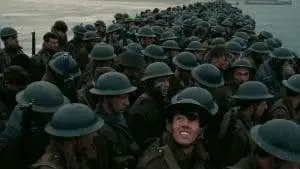
Christopher Nolan is a filmmaker I admire for avoiding the easy way out, and he can also be frustrating because his narrative contortions sometimes prevent what could have been gripping stories from becoming involving. As a result, his movies can sometimes be more engaging after they’ve stopped running than they are in the theater.
In the case of his new offering Dunkirk, the mind behind the time-twisting Memento, Inception and The Dark Knight, Nolan seems to be inspired by the nearly 400,000 Allied troops staring out at the sea off of Northern France in late May and early June of 1940.
While all would love to quickly escape from advancing Nazi forces, they can’t.
German tanks surround the seaport from the land. They even drop down fliers of maps in English, letting the Brits, the French and the Belgians know that they’ll soon be prisoners or casualties. For the few military vessels that are available, the tide delays their departure.
German fighters buzz overhead and pick off troops who don’t have anywhere else to go. If the ocean itself weren’t enough of a hazard, the Germans have U-boats ready to sink any ship sailing out of or into the area. It’s no wonder that a Royal Navy officer on the scene, Commander Bolton (Kenneth Branagh) is seriously contemplating surrender.
With all the obvious dangers, Nolan doesn’t have to blitzkrieg viewers with gore to make the audience reach for anti-anxiety meds. While Saving Private Ryan and Hacksaw Ridge would have been lesser movies for downplaying how gruesome Operation Overlord and the Battle of Okinawa were, Nolan’s restraint is an asset, especially during the opening sequences.
When a British soldier named Tommy (Fionn Whitehead) and his mates arrive in Dunkirk, it seems as if the city is nearly deserted, with no essentials like food, cigarettes or running water. The contents of ashtrays look awfully tempting, and Tommy’s bowels help him find a use for those needlessly abundant German leaflets.
Tommy and his cohorts quickly learn that that lonely and safe are two distinct conditions. Gunfire breaks out, and it’s impossible to tell if the people firing are French or German. When Tommy arrives at the beach, the sheer number of people living and dead is overwhelming. With the all those souls facing the shore, Nolan makes it clear that danger is imminent and that escape is increasingly unlikely.
If you’ve wandered over to Google or had a history lesson, you know that getting away was exceedingly difficult but not impossible. The Brits escaped because the government commissioned a large flotilla of civilian vessels. The feat seems even more astounding because many of these boats were not intended as troop carriers and could not fight back if the Germans fired a torpedo or attacked from the air.
Dunkirk follows a tourist boat called The Moonstone as its pilot Mr. Dawson (Mark Rylance), his son Peter (Tom Glynn-Carney) and Peter’s teenage friend George (Barry Keoghan) head to France to pick up as many troops as possible before the Nazis get to them.
The scenes on The Moonstone are the most involving of the film in part because Rylance is a master of underplaying just about every conceivable emotion. He has a remarkable finesse with Shakespeare, but he never feels the need to advertise what’s going on in Mr. Dawson’s head. His sighs or shrugs covey far more than most soliloquies.
The Royal Air Force are able to send a few fighters to defend the large but lowly fleet headed toward France. While Farrier (Tom Hardy) reduces the Luftwaffe’s best planes to scrap metal, he has to calculate his fuel usage by hand because his gauge is out. The dogfights are impressive, with special effects that don’t look like special effects. The muddy dialogue is actually a plus. It’s doubtful that Spitfires had Dolby-quality sound, especially when their pilots were returning German fire. There’s little point of struggling to make out Hardy’s mumbled banter when the visuals make the situation obvious.
Nolan structures Dunkirk in three distinct but interlocking tales: Tommy on the shore, The Moonstone on the open water and Farrier and his comrades in the air. During the middle of Dunkirk, it’s tricky to tell who is who with the troops on the beach and in some of the Royal Navy vessels because they all look and sound so similar. The Dunkirk evacuation was such an inspiring feat that The Room mastermind Tommy Wiseau might, under the right circumstances, make an almost watchable film of the event.
With Nolan, we certainly get more, but when the characters get lost in the gunfire, smoke and water, their fate isn’t involving as it could have been. Nolan’s three-legged stool does work because the evacuation was too complex to be carried by a single narrative.
Presenting a single storyline would have shortchanged the logistical challenges involved, but Dunkirk’s lean 106-minute running time could have been a little bit longer to help certain characters make more of an impression. Cillian Murphy’s brief turn as an understandably shell-shocked sailor leaves more of an impact than the performances of actors who have more screen time.
What Nolan gets right in Dunkirk from the action to the spare dialogue is so good that it makes the fact that any narrative deficiencies exist seem all the more disappointing. He’s a smart enough filmmaker to know that presenting Dunkirk without a sense of the “fog of war” would make his tribute to the heroes involved feel hollow. I have a strange feeling I might have enjoy Dunkirk more on a second viewing when I know the parameters and can concentrate on the brave people who made it possible.
Dunkirk (2017) Directed by: Christopher Nolan. Written by: Christopher Nolan. Starring: Fionn Whitehead, Aneurin Barnard, Mark Rylance, Tom Glynn-Carney, Tom Hardy, Jack Lowden, Cillian Murphy, Barry Keoghan, Kenneth Branagh, Harry Styles.
8 out of 10


